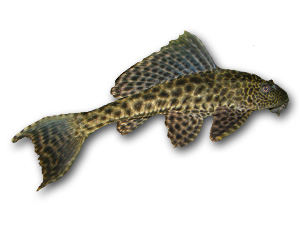Pleco

Quick Stats
| Size | 20" (51cm) |
|---|---|
| Tank | 300 litres + when fully grown. |
| Swimming Area | Bottom, all surfaces in the tank and decor. |
| Ph | 6.4 to 7.6 |
| Temperature | 72ºF to 86ºF (22-30°C) |
| Food | Algae, veggies and sinking tablet foods. |
Common Name:
Pleco
Distribution:
Amazonia, in Peru, Bolivia and Paraguay.
Colouration:
The overall coloration appears to be a dark Brown. The upper-side is Brown with dark Brown spots and often has up to five wide dark transverse bands. The belly is creamy white, without markings The fins are also Brown, with rows of dark Brown spots between the rays. The nose has a thin band connecting the nostrils.
Lifespan:
7 to 15 Years.
Maintenance:
10 to 20% weekly water changes. The Plecos are all twilight animals and are most active at this time. They generally leave small fish alone, but occasionally will eat any that present themselves to them. They are hardy and undemanding in the water parameters, but will do best in soft water with a temperature in the mid seventies. The pleco is very long lived and will make a fantastic addition to any tank.
Feeding:
A diet high in vegetable matter is essential to their health and can be supplemented with Romaine lettuce or boiled spinach. Too much animal matter in the diet can cause digestive problems. Keep some wood in the tank since rasping algae from the wood provides a perfect place for more algae to grow maintaining a constant food source for this fish. Also, the cellulose in wood is necessary for their digestive process. Herbivorous - Does eat algae but diet needs to be supplimented with algae wafers and/or fresh green vegetables such as spinach, romaine lettuce or zucchini slices.
Substrate:
A soft substrate is beneficial as some like to burrow.
Tank Decor:
Large well planted community aquarium with pieces of driftwood for scraping.
Filtration:
Standard filter suitable for the size of the tank.
Biotype:
Calm, slow moving waters of the amazon and its tributaries.
Breeding:
Breeding of members in the family Loricariidae has been done fairly regularly. The aquarium should have tubes or clay pipes with a fairly large diameter. The male will clean the site and will fan water over the eggs and fry. At a temperature of about 70f the eggs will hatch in about nine days. The fry will eat small flake food as well as baby brine shrimp and algae scrapings. They are not the easiest to raise and a bare bottom tank is best.